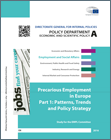Precarious work - a slippery concept?
9 Sep 2016
 Andrea Broughton, Principal Research Fellow
Andrea Broughton, Principal Research Fellow
Precarious work is an issue that sparks a great deal of controversy, particularly in these post-crisis times of cautious economic recovery. The past few months have seen a labour market upturn, but has this been at the cost of secure employment? Recent reports of poor and insecure employment terms and conditions at Sports Direct and Deliveroo have heightened the debate.
However, there is no real definition of what precarious work actually is. Whether or not a job is precarious depends on a number of factors, such as the standpoint of the observer – trade unions will have a different view from employers, for example – and that of the individual worker. A student or young person entering the labour market, with few financial responsibilities, may very well welcome the flexibility and experience that zero-hours contracts can bring, although they would at some point want to move into work that is more stable. However, zero-hours contracts do not offer enough security, in terms of working hours and pay, for anyone with financial or family responsibilities or a need to plan their working life.
IES has looked at this issue recently, in research that we carried out for the European Parliament*. Given that there is no consensus on what precarious work is, we looked at a range of indicators – in-work poverty and low pay, social security, labour rights, stress and health, career development and training, and low levels of collective rights – and assessed their prominence in different types of employment contract. Our overall conclusion was that all types of work carry some risk of precariousness, although the risk increases in the case of atypical working.
This means that even those in full-time, open-ended employment can be at some risk of precariousness if they are working in jobs or sectors that are low paid and have poor working conditions. This can include, for example, people working in personal services (such as cleaners and hairdressers) and hospitality, in addition to drivers and refuse workers. Their jobs may be secure in the sense of having full-time hours and not being employed on a fixed-term basis, but they may be precarious in that they do not earn enough to sustain a decent standard of living, and may have to work in difficult and pressured conditions.
Those working on the basis of time-limited contracts (temporary agency work, fixed-term contracts, and seasonal or casual work) are at greater risk of precariousness. Temporary agency working only accounts for around 1.5 per cent of employment in the EU, but fixed-term contracts account for around 7 per cent overall. Apart from the fact that there is no guarantee of the work continuing, those on these types of contracts will not have access to a range of employment rights, such as the right to claim unfair dismissal, that are linked to length of service. Gaps in employment between contracts will also reduce social security and pension coverage.
Internships are a form of temporary working, and have caused a fair degree of controversy as they are often unpaid or low paid. There are also issues in terms of the quality of the placements and the danger of young people becoming trapped in lengthy cycles of unpaid internships.
Of course, fixed-term and temporary working may well suit many individuals. The issue is whether those who want to use temporary working as a stepping stone into more permanent forms of employment are able to do that: on average, only around 23 per cent of temporary employees in the EU find a permanent job within a year. The UK does rather better than the EU average, however, at over 60 per cent.
Another issue is whether or not people choose to work in non-standard ways. Our research showed that 35 per cent of workers in the UK who are working on a fixed-term contract would prefer a permanent contract. Similarly, 17 per cent of part-time workers in the UK do so involuntarily.
The rise of so-called ‘bogus’ self-employment is also a concern. As organisations have reduced headcounts in order to cut payroll costs in recent years, many of those who have been made redundant have become self-employed. However, some carry on working for their former employer, but on an outsourced, self-employed basis, rather than as an employee. This sort of bogus self-employment carries a high risk of precariousness, largely in terms of lack of access to employment rights and social security benefits.
At the heart of this is the need to find a balance between giving employers (and in many cases employees too) the flexibility they need to respond to demand for goods and services in a cost-effective way and the need to ensure a decent working life for individual workers. The government has a role to play in ensuring that legislation is adhered to and that any loopholes are closed, while interested parties can play their part in trying to build an economy based on effectiveness and fairness.
It is certain that atypical forms of work are on the increase – standard forms of contract now only account for 59 per cent of all contracts in the EU, down from 62 per cent in 2003, and if this trend continues, it may well be that atypical contracts will become the main form of contracting in the longer term. It could be argued that this is already so in the case of young people and in some sectors. Further, if UK employment law is relaxed in the wake of Brexit, this could trigger a further increase in atypical working.
As to the question of whether precarious working necessarily equates to atypical contracts, the answer would appear to be that it is more likely that many forms of atypical work carry a higher risk of precariousness, although the risk is not confined to atypical work.
Read the reports
 Precarious Employment in Europe: Patterns, Trends and Policy Strategies
Precarious Employment in Europe: Patterns, Trends and Policy Strategies
Precarious Employment in Europe: Country Case Studies
Any views expressed are those of the author and not necessarily those of the Institute as a whole.




